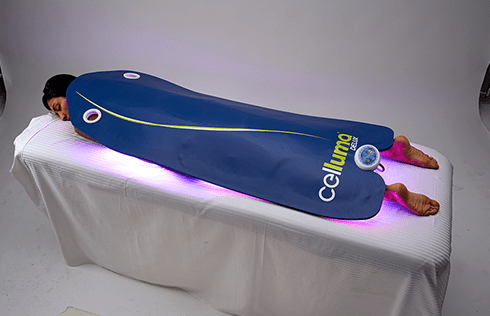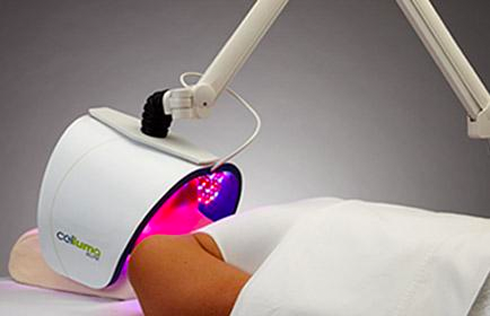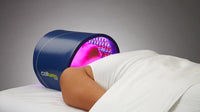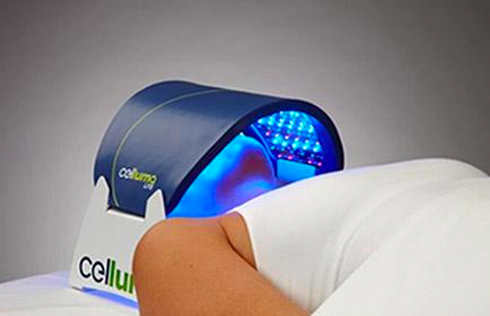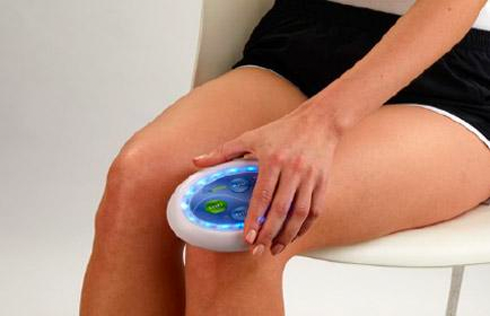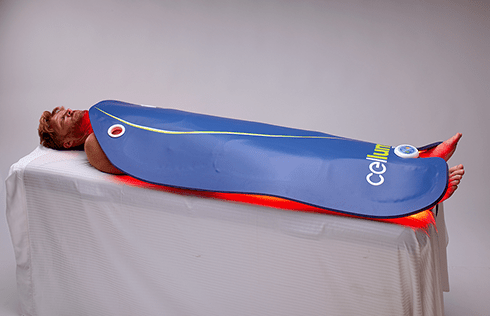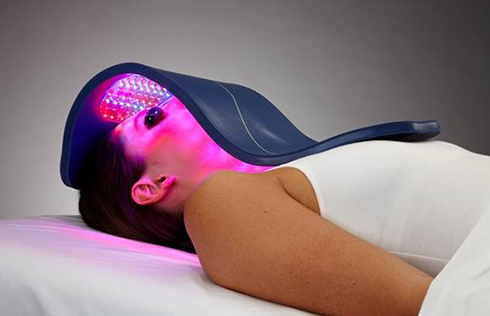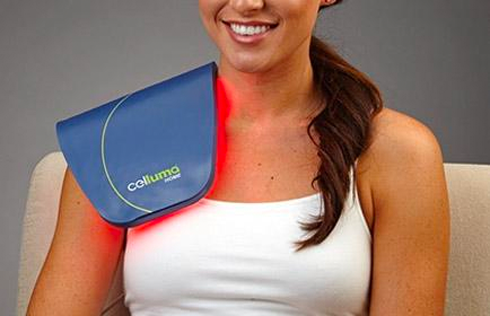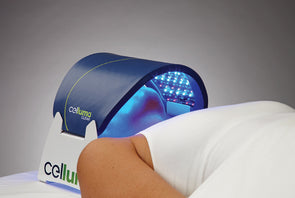The 3-mode Celluma RESTORE* is the first red light
therapy device to be FDA-cleared to treat three common
concerns of the mature individual in a single LED light
therapy machine.
LED Red Light Therapy for Hair Loss
The 3-mode Celluma RESTORE is the first red light therapy device to be FDA-cleared to treat three common concerns of the mature individual in a single LED light therapy machine. Addressing hair growth, aging skin, and general skin conditions, including acne, the Celluma RESTORE is versatile, convenient, and easy-to-use in a clinical setting or at home. Celluma’s patented, shape-taking design permits customized placement over the head to effectively deliver red light light energy and promote hair growth.
What Causes Hair Loss
There are many different causes for hair loss including genetics, stress, poor nutrition, or as a side effect of taking a particular medication. Here’s a basic break down of what happens when hair loss becomes a problem.
Basically, when hair loss happens, you do lose the hair but what you don’t lose is the actual hair follicle which is what helps keep the hair attached to the skin. Each hair follicle contains a hair bulb at its base which contain the papilla and the matrix and this is where your hair begins the growth process.
Our hair is made up of a protein called keratin which makes up the hair shaft. When all of these pieces of the hair puzzle are not functioning optimally, proper hair growth just isn’t in an environment where it can thrive.
Who Suffers from Hair Loss?
Hair loss can be temporary or permanent. It can be heredity, the result of medical conditions, or hormonal changes. It is generally considered a normal part of aging and affects both men and women alike.
Hair Loss and Men
Male pattern baldness, also known as androgenetic alopecia (AGA), accounts for 95% of hair loss in men. Research shows that by age 35, more than two thirds of American men suffer from hair loss and by age 50, 85% of men deal with thinning hair.
Androgenetic alopecia is a common hair loss condition that is characterized by the miniaturization of hair follicles in the frontal and parietal regions of the scalp. All this means is that there are approximately 35 million men in the United States dealing with hair loss.
While many men have embraced the “bald is beautiful” mantra, there are others who suffer from male pattern baldness and are extremely unhappy with how they look, particularly men who begin balding at a young age. Many are desperate for solutions and for some, it can impact interpersonal relationships as well as their professional options.
The bottom line is that the market for real hair restoration solutions is booming. Light therapy for hair compliments currently existing treatments and procedures (prescription drugs, PRP, stem cells, transplant surgery) to enhance an individual’s outcome for maximizing hair growth.
When it comes to restoring hair loss, there are many treatment options available including a drug called minoxidil (Rogaine®). There is also a pill called finasteride or its brand name for hair loss, Propecia. However, surgery is expensive, and many are looking for a drug-free and pain free option to avoid unwanted side effects.
Hair Loss and Women
Hair loss is not a strictly male health concern. While suffering mostly in silence, women make up a significant percentage of those who suffer from hair loss. According to the American Academy of Dermatology, 40% of women have visible hair loss by the time they are age 40. Many procedures and products are marketed to men to help with hair loss, while women are relegated to thickening shampoos and collagen supplements.
Hair loss in women can have an emotional toll impacting their self-image and potentially their mental and emotional well-being. For many women, this can be a life altering condition. Women no longer need to suffer in silence.
Why Does Hair Loss Occur
Hair loss is typically related to one or more of the following factors:
- Family history (heredity). The most common cause of hair loss is a hereditary condition that occurs with aging. This condition is called androgenetic alopecia, or male-pattern and female-pattern baldness. It usually occurs gradually and in predictable patterns — a receding hairline and bald spots in men and thinning hair along the crown of the scalp in women.
- Hormonal changes and medical conditions. A variety of conditions can cause permanent or temporary hair loss, including hormonal changes due to pregnancy, childbirth, menopause, and thyroid problems. Medical conditions include alopecia areata, which is immune system related and causes patchy hair loss, scalp infections such as ringworm, and a hair-pulling disorder called trichotillomania.
- Medications and supplements. Hair loss can be a side effect of certain prescription medications, such as those used for cancer, arthritis, depression, heart problems, gout, and high blood pressure.
- Radiation therapy to the head. The hair may not grow back the same as it was before.
- A very stressful event. Many people experience a general thinning of hair several months after a physical or emotional shock. This type of hair loss is temporary.
- Hairstyles and treatments. Excessive hairstyling or hairstyles that pull your hair tight can cause a type of hair loss called traction alopecia.
Complete hair loss or baldness typically refers to excessive hair loss from the scalp. Hereditary hair loss with age is the most common cause of baldness. Some people prefer to let their hair loss run its course untreated and unhidden. Others may cover it up with hairstyles, makeup, hats or scarves. Today many sufferers are taking advantage of FDA-cleared red light therapy devices to treat and prevent further hair loss.
Photobiomodulation Response From Red Light
According to research, photobiomodulation, (PBMT) using wavelengths in the visible red spectrum have been sown to have noticeable cell stimulation which helps restore normal cellular function. The cyclic growth of hair follicles is powered by hair follicle stem cells (HFSCs). It is thought that through PBMT, red light energy emitted by low-level light therapy (LLLT) devices may encourage hair growth by accelerating keratinocyte and fibroblast mitosis, inhibiting nitric oxide, and reducing inflammation. (3-6)
What the Research Says about Red Light Therapy and Hair Regrowth
Several studies have examined the use of red light therapy on hair regrowth, including how it impacts the scalp and follicles. A paper published in February 2014 titled, Low-level Light Therapy (LLLT) for Treatment of Hair Loss, said “LLLT was discovered serendipitously in the 1960s when mice irradiated with a low fluence red laser grew hair. Since that time LLLT has demonstrated promise in conditions from wound healing to stroke recovery, from treatment of musculoskeletal pain to prevention of mucositis. Animal and human data have slowly accumulated supporting LLLT for hair growth (Table 1). LLLT appears to improve a variety of non-scarring alopecias—AGA, AA, and chemotherapy-induced alopecia. Based on the studies demonstrating LLLT's effects on promoting graft survival, it may be further suggested to have a potential to be used during the immediate period of post-hair transplant surgery to facilitate the healing process and enhance viability and earlier growth of the grafts [60,61]. While mechanisms are still emerging, LLLT may increase anagen hairs through release of NO from CCO by photodissociation and LLLT may reduce inflammation in AA. However, more studies are needed to optimize treatment parameters and determine long-term efficacy as well as safety of emerging LLLT technologies. Most studies investigating effects of LLLT on hair growth have used wavelengths that range from 635 to 650 nm, but as of today no study has compared the effect of near-infrared wavelengths such as 810 nm, which have deeper penetrating capacities, to red light. Moreover, further studies are required to compare efficacy of different light sources (continuous vs. pulsed) and methods of light delivery (laser vs. LED).”
In a study published in September 2021 titled, “Treatment options for androgenetic alopecia: Efficacy, side effects, compliance, financial considerations, and ethics,” researchers found that, “overall, literature has suggested light therapy to be a safe treatment modality for AGA in both male and female patients when used independently or in combination with topical/oral therapies. Light therapy has an excellent side effect profile, and there are no contraindications for use, although caution may be taken when administering in patients with dysplastic lesions on the scalp.”
“Light therapy is ideal for patients who prefer non-invasive options, or for those who lack a flexible schedule to come into the office for regular treatments. These devices can be self-administered at home and controlled by a mobile application to also record daily compliance.”
Is the Celluma RESTORE Right for You?
The Norwood Hamilton Scale and Ludwig-Savin Scale are used to help determine if light therapy will work for an individual. Celluma is not FDA-cleared to treat the stages of hair loss that are greyed out on both scales.

About Celluma RESTORE:
- Reverse Hair Loss
- Rejuvenate Aging Skin
- Prevent Further Hair Loss
- Counter male and female pattern balding (androgenetic alopecia)
- Non-toxic/non-invasive
- Pain free
Fitzpatrick Skin Types
The Celluma RESTORE LED red light therapy system is indicated for males and females with skin types I-IV. If you suffer from androgenetic alopecia and have Fitzpatrick skin type V-VI, then the Celluma RESTORE LED system is NOT suitable for you.

Light therapy shows minimal degrees of side effects and adverse events (Hamblin 2014).

Red Light for Hair Growth and Baldness
Red light LED devices have been cleared by the FDA for the treatment of male and female pattern hair loss. Substantial research has supported light therapy’s ability to regrow hair lost due to androgenetic alopecia with minimal degrees of side effects and adverse events.
Light therapy for hair can be an effective stand-alone therapy or adjunctive therapy to medication and topical prescriptions for optimal hair regrowth. Dermatologists and medical practitioners specializing in hair restoration can ensure proper diagnosis and treatment recommendations. Individuals should consult with their physician for a correct diagnosis and to determine if light therapy is suitable for their category of hair loss.
Patients can experience light therapy in a clinical setting, as well as purchase a suitable LED device to complete treatment in the convenience of their own home without repeated office visits. It is also non-invasive, non-toxic and painless.
In one review article, Efficacy of non-surgical treatments for androgenetic alopecia: a systematic review and network meta-analysis (© 2018 European Academy of Dermatology and Venereology), A.K. Gupta, et al, states that, “Relative effects show LLLT as the superior treatment” when comparing light therapy to the six most common non-surgical treatment options for treating androgenetic alopecia in both men and women including dutasteride 0.5 mg, finasteride, 1 mg, minoxidil 2%, minoxidil 5% and platelet-rich plasma (PRP).
The Celluma RESTORE now offers both women and men a non-invasive, non-toxic solution to many forms of hair loss (reference chart). Call today to talk to a Clinical Specialist about how the Celluma RESTORE can help with not only hair restoration but also anti-aging and acne — all in a single device!





The Celluma RESTORE measures 16” x 8” overall with a treatment area of 14” x 6”.
Protocol for Treating Hair Loss:
To obtain the best results use Celluma RESTORE every other day, for 16 weeks.
- Each Treatment: 30 min
- Before use ensure that your hair and scalp are clean
- Before use ensure that your hair and scalp are completely dry
- Separate the hair before illumination to expose the parts of the scalp suffering from hair loss
*Individuals should first consult with their doctors when making any change to their existing medical and drug routines.
References:
1. Fuchs C, Schenk MS, Pham L, Cui L, Anderson RR, Tam J. Photobiomodulation Response From 660 nm is Different and More Durable Than That From 980nm. Lasers Surg Med. 2021 Nov;53(9):1279-1293. doi: 10.1002/lsm.23419. Epub 2021 May 16. PMID: 33998008.
2. Chen CL, Huang WY, Wang EHC, Tai KY, Lin SJ. Functional complexity of hair follicle stem cell niche and therapeutic targeting of niche dysfunction for hair regeneration. J Biomed Sci. 2020 Mar 14;27(1):43. doi: 10.1186/s12929-020-0624-8. PMID: 32171310; PMCID: PMC7073016.
3. Lubart R, Eichler M, Lavi R, Friedman H, Shainberg A. Low-energy laser irradiation promotes cellular redox activity. Photomed Laser Surg 2005; 23: 3–9.
4. Eells JT, Wong-Riley MTT, VerHoeve J et al. Mitochondrial signal transduction in accelerated wound and retinal healing by near-infrared light therapy. Mitochondrion 2004; 4: 559–567.
5. Sakurai Y, Yamaguchi M, Abiko Y. Inhibitory effect of low-level laser irradiation on LPS-stimulated prostaglandin E2 production and cyclooxygenase-2 in human gingival fibroblasts. Eur J Oral Sci 2000; 108: 29–34.
6. Darwin E, Heyes A, Hirt PA, Wikramanayake TC, Jimenez JJ. Low-level laser therapy for the treatment of androgenic alopecia: a review. Lasers Med Sci 2017; 33: 425–434.


